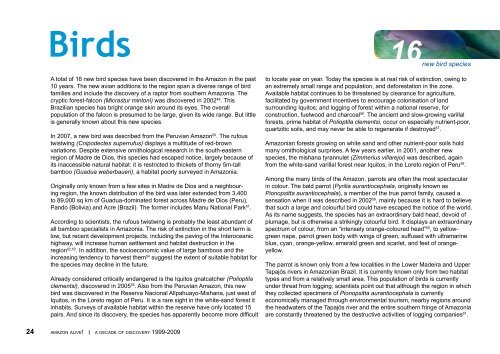Amazon Alive: A Decade of Discoveries 1999-2009 - WWF
Amazon Alive: A Decade of Discoveries 1999-2009 - WWF
Amazon Alive: A Decade of Discoveries 1999-2009 - WWF
You also want an ePaper? Increase the reach of your titles
YUMPU automatically turns print PDFs into web optimized ePapers that Google loves.
Birds<br />
16new bird species<br />
A total <strong>of</strong> 16 new bird species have been discovered in the <strong>Amazon</strong> in the past<br />
10 years. The new avian additions to the region span a diverse range <strong>of</strong> bird<br />
families and include the discovery <strong>of</strong> a raptor from southern <strong>Amazon</strong>ia. The<br />
cryptic forest-falcon (Micrastur mintoni) was discovered in 2002 49 . This<br />
Brazilian species has bright orange skin around its eyes. The overall<br />
population <strong>of</strong> the falcon is presumed to be large, given its wide range. But little<br />
is generally known about this new species.<br />
In 2007, a new bird was described from the Peruvian <strong>Amazon</strong> 50 . The rufous<br />
twistwing (Cnipodectes superrufus) displays a multitude <strong>of</strong> red-brown<br />
variations. Despite extensive ornithological research in the south-eastern<br />
region <strong>of</strong> Madre de Dios, this species had escaped notice, largely because <strong>of</strong><br />
its inaccessible natural habitat: it is restricted to thickets <strong>of</strong> thorny 5m-tall<br />
bamboo (Guadua weberbaueri), a habitat poorly surveyed in <strong>Amazon</strong>ia.<br />
Originally only known from a few sites in Madre de Dios and a neighbouring<br />
region, the known distribution <strong>of</strong> the bird was later extended from 3,400<br />
to 89,000 sq km <strong>of</strong> Guadua-dominated forest across Madre de Dios (Peru),<br />
Pando (Bolivia) and Acre (Brazil). The former includes Manu National Park 51 .<br />
According to scientists, the rufous twistwing is probably the least abundant <strong>of</strong><br />
all bamboo specialists in <strong>Amazon</strong>ia. The risk <strong>of</strong> extinction in the short term is<br />
low, but recent development projects, including the paving <strong>of</strong> the Interoceanic<br />
highway, will increase human settlement and habitat destruction in the<br />
region 52,53 . In addition, the socioeconomic value <strong>of</strong> large bamboos and the<br />
increasing tendency to harvest them 54 suggest the extent <strong>of</strong> suitable habitat for<br />
the species may decline in the future.<br />
Already considered critically endangered is the Iquitos gnatcatcher (Polioptila<br />
clementsi), discovered in 2005 55 . Also from the Peruvian <strong>Amazon</strong>, this new<br />
bird was discovered in the Reserva Nacional Allpahuayo-Mishana, just west <strong>of</strong><br />
Iquitos, in the Loreto region <strong>of</strong> Peru. It is a rare sight in the white-sand forest it<br />
inhabits. Surveys <strong>of</strong> available habitat within the reserve have only located 15<br />
pairs. And since its discovery, the species has apparently become more difficult<br />
to locate year on year. Today the species is at real risk <strong>of</strong> extinction, owing to<br />
an extremely small range and population, and deforestation in the zone.<br />
Available habitat continues to be threatened by clearance for agriculture,<br />
facilitated by government incentives to encourage colonisation <strong>of</strong> land<br />
surrounding Iquitos; and logging <strong>of</strong> forest within a national reserve, for<br />
construction, fuelwood and charcoal 56 . The ancient and slow-growing varillal<br />
forests, prime habitat <strong>of</strong> Polioptila clementsi, occur on especially nutrient-poor,<br />
quartzitic soils, and may never be able to regenerate if destroyed 57 .<br />
<strong>Amazon</strong>ian forests growing on white sand and other nutrient-poor soils hold<br />
many ornithological surprises. A few years earlier, in 2001, another new<br />
species, the mishana tyrannulet (Zimmerius villarejoi) was described, again<br />
from the white-sand varillal forest near Iquitos, in the Loreto region <strong>of</strong> Peru 58 .<br />
Among the many birds <strong>of</strong> the <strong>Amazon</strong>, parrots are <strong>of</strong>ten the most spectacular<br />
in colour. The bald parrot (Pyrilia aurantiocephala, originally known as<br />
Pionopsitta aurantiocephala), a member <strong>of</strong> the true parrot family, caused a<br />
sensation when it was described in 2002 59 , mainly because it is hard to believe<br />
that such a large and colourful bird could have escaped the notice <strong>of</strong> the world.<br />
As its name suggests, the species has an extraordinary bald head, devoid <strong>of</strong><br />
plumage, but is otherwise a strikingly colourful bird. It displays an extraordinary<br />
spectrum <strong>of</strong> colour, from an “intensely orange-coloured head” 60 , to yellowgreen<br />
nape, parrot green body with wings <strong>of</strong> green, suffused with ultramarine<br />
blue, cyan, orange-yellow, emerald green and scarlet, and feet <strong>of</strong> orangeyellow.<br />
The parrot is known only from a few localities in the Lower Madeira and Upper<br />
Tapajós rivers in <strong>Amazon</strong>ian Brazil. It is currently known only from two habitat<br />
types and from a relatively small area. This population <strong>of</strong> birds is currently<br />
under threat from logging; scientists point out that although the region in which<br />
they collected specimens <strong>of</strong> Pionopsitta aurantiocephala is currently<br />
economically managed through environmental tourism, nearby regions around<br />
the headwaters <strong>of</strong> the Tapajós river and the entire southern fringe <strong>of</strong> <strong>Amazon</strong>ia<br />
are constantly threatened by the destructive activities <strong>of</strong> logging companies 61 .<br />
24 amazon alive! I a decade <strong>of</strong> discovery <strong>1999</strong>-<strong>2009</strong>

















